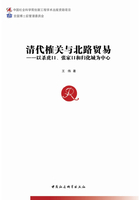
ABSTRACT
In the Qing Dynasty,the scope of circulation of commodities in China has expanded significantly over the Ming Dynasty. With the opening up of maritime restrictions,North China Plain,the upper reaches of the Yangtze River in the economic development of provinces,as well as the Northeast,Taiwan,coastal,river trade has been large-scale expansion,in addition,Xinjiang,Mongolia’s trade with the Mainland has been developed. In particular,especially northern border area trade activities has made a strong impetus to the unexpectedly economical development in the Northern border area society,but also take the Sino-Russian kyakhta trade as the turning point,and ultimately take China into the center of an international regional markets. It can be seen that the North Trade in the Qing Dynasty has already constituted the very important part of the Chinese commercial history developing process,which has been the main force in the process of modernization. At the same time,the gains of customs has become important state revenue in the Qing Dynasty,which can objectively reflect the nationwide longdistance circulation of commodities and the level of regional economic development.
In this book,the author take the Shahukou,Zhangjiakou and Guihua city as the center,and use a large number of files in the China’s National Palace Museum and the Taipei Palace Museum to reveal the general path of the development of North Trade,included the historical evolution of three customs,internal personnel and tax administration,the change of fixed tax,in particular,the volatility of actual tariffs and the specific distribution,trade statistics,as well as the estimates of actual trade. This book specifically has highlighted the method which the historical real diagnosis and the measurement analysis unify,and adhere to the basic principles of the“theory from the history”. Generally speaking,the development of three customs has clearly shown that the close inner link between the customs and the North Road the Qing Dynasty. On the one hand,The active business circulation promoted the formation and the development of the customs; on the other hand,the improvement of customs brought further social goods around the region’s economic prosperity.
This book shows that,in the more stable social environment,animal husbandry economic development and the urgent need for daily business of the production of the Mongolian People,and Han nationality in favor of animal has formed a kind of interaction relations. Therefore,“mutual,beneficial to people’s livelihood”has become a characteristic of North Trade in the Qing Dynasty,which reveals the reason for the North Trade’s prosperities. Therefore,the generation and evolution of Shahukou,Zhangjiakou and Guihua city will be endowed with a strong historical and geographical characteristics,which has been different from the development of coastal trade.
Due to the specificity of the North Trade in the Qing Dynasty,the Qing government implements a more stable management for Shahukou,Zhangjiakou and Guihua city. From the above analysis point of view,although North Trade assumes the political task of the Qing government,at the same time,it shoulders the responsibility for maintaining the growing financial demand of the internal affairs government and protecting the military garrison. Therefore,the North Trade in the Qing Dynasty has developed in the relatively more open and free environment. Of course,the development process has not always been smooth,however,even in the face of the barriers of so-called the policy of closeddoor,vibrant non-governmental trade has impetus the North Trade develops forward.
From the results of the quantitative analysis,due to a variety of objective factors,the volume of the North Trade estimated from three customs’tariffs is the minimum value of trade flows. In the Qing Dynasty,the development of the North Trade can be divided into five stages,that is rising in the twists and turns of the Qianlong period,to maintain prosperity and stability in the Jiaqing and daoguang period,suffered setback in the Xianfeng period,two forces progressive differentiation in Tongzhi time,as well as the turbulent period in Guangxu time. As for the Influencing factors for the North Trade,from the objective,which mainly reflected in the national policy environment,poor situation and the impact of natural disasters; from a subjective term,the customs’management system and businessmen’s evasion are the insurmountable barrier to the development of North Trade.
The track of development of the North Trade reveals an important conclusion: The trade between Han Nationality and Mongolian national minority,as well as Sino-Russian kyakhta trade are the two forces of the North Trade in the Qing Dynasty. Their prosperities urged a market circle between the northern China border area and Russia in the Qing Dynasty. In other words,No matter what kind of trade,the final results are the prosperity of the regional market. Therefore,even a partial crisis was produced in the more mature market,which will not immediately affect the entire North Trade.
In this context,Shahukou,Zhangjiakou and Guihua city have become the key position and business portal hub to the north-west region and northern regions of Russia and Mongolia,which are in a significant expansion and increased gradually both in the size of the market building itself,or the flow of goods in bulk quantity and type. Among them,Shahukou reflects the market functions for import and export commodities. Zhangjiakou and Guihua city are not only the“transfering station”for import and export of goods,but also an important goods distribution center and the commercial cities and towns relied on by the well known business firms. Thus,Shahukou,Zhangjiakou and Guihua city play a key role in the development of the North Trade,which have actively promoted the development of North Trade. There is no doubt that they are bound to have been fully equipped with the functions of the hub cities in the network market system of urban and rural areas in the northern China,which has confirmed that the North Trade had made the outstanding contributions to the modernization of the Northern China in the Qing Dynasty.
Key words: Qing Dynasty; Customs house; North Trade; Customs duties; Volume of the trade